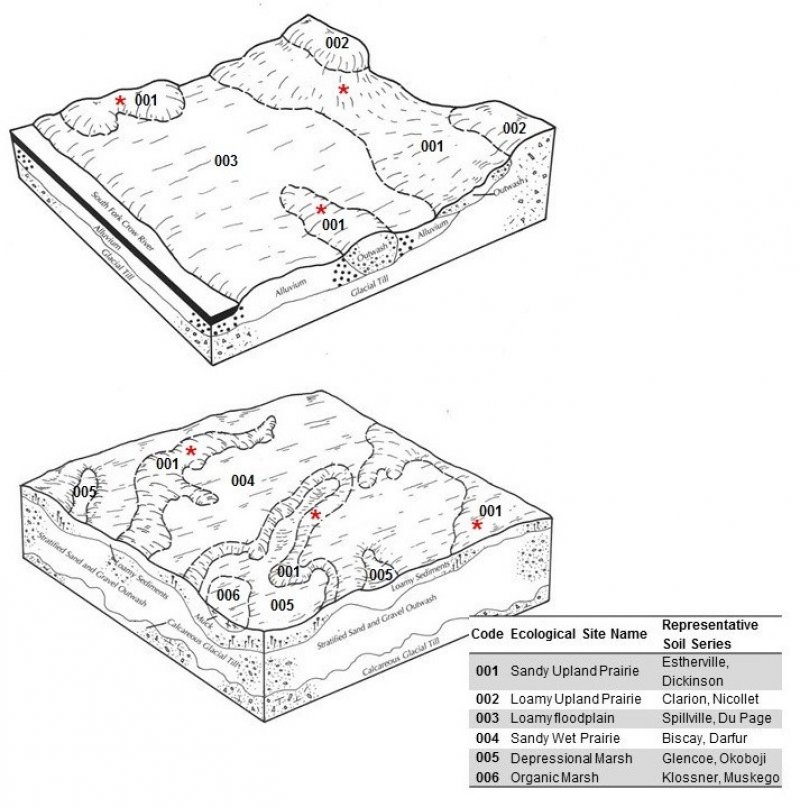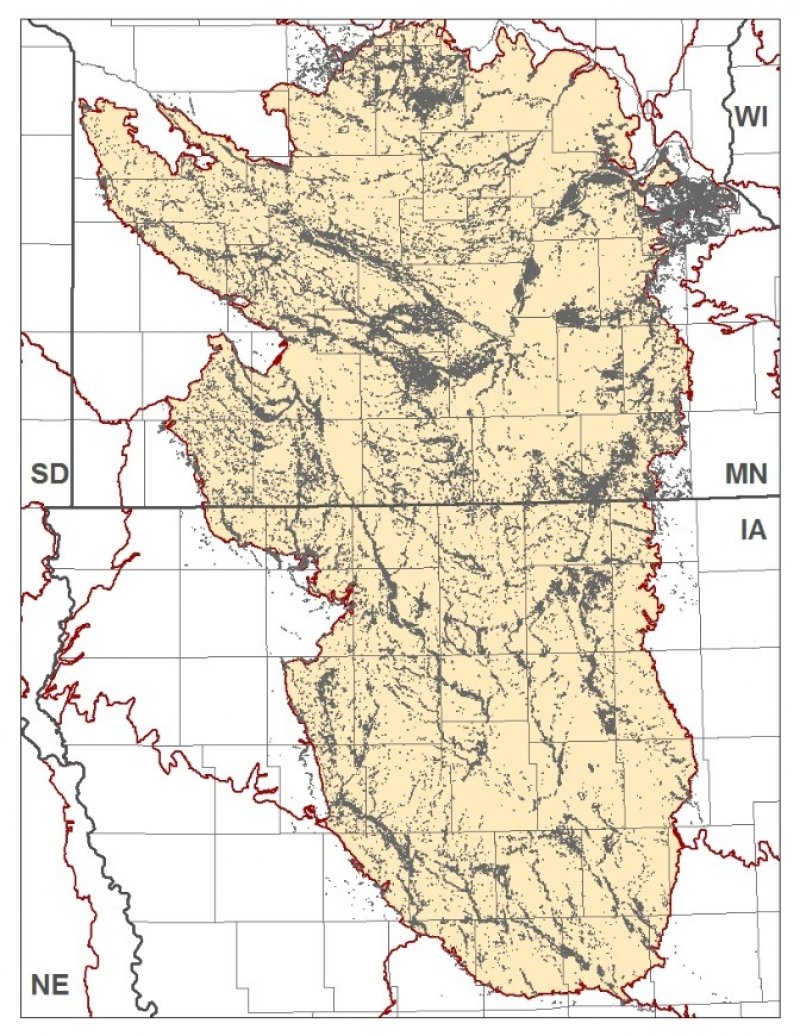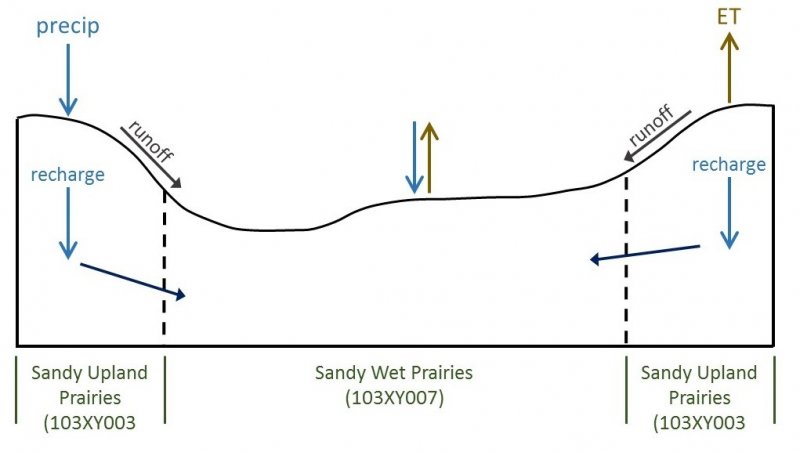
Natural Resources
Conservation Service
Ecological site R103XY003MN
Sandy Upland Prairies
Last updated: 10/04/2023
Accessed: 12/22/2024
General information
Provisional. A provisional ecological site description has undergone quality control and quality assurance review. It contains a working state and transition model and enough information to identify the ecological site.
MLRA notes
Major Land Resource Area (MLRA): 103X–Central Iowa and Minnesota Till Prairies
MLRA 103 is in Minnesota (56 percent) and Iowa (44 percent) and consists of approximately 18 million acres. It is in the Western Lake Section of the Central Lowland Province of the Interior Plains in an area known as the "Des Moines Lobe" of the Wisconsin-age ice sheet. The MLRA is mostly on a young, nearly level to gently rolling, glaciated till plain that has moraines and glacial lake plains in some areas. The plain is covered with glacial till, outwash, and glacial lake deposits. Recent alluvium consisting of clay, silt, sand, and gravel fill the bottoms of most of the major river valleys. Paleozoic bedrock sediments, primarily shale and limestone, underlie the glacial deposits in most of the area.
The annual precipitation increases from northwest to southeast. Most of the rainfall occurs as high-intensity, convective thunderstorms during the summer. Two-thirds or more of the precipitation falls during the freeze-free period. Snowfall is common in winter. Groundwater supplies are adequate for the domestic, livestock, municipal, and industrial needs. Nearly all of this area is farmland, and about four-fifths is cropland.
Classification relationships
Major Land Resource Area (MLRA): Central Iowa and Minnesota Till Prairies (103) (USDA Handbook 296, 2006)
USFS Subregions: North Central Glaciated Plains Section (251B); Upper Minnesota River-Des Moines Lobe (251BA) and Southern Des Moines Lobe (251Be) Subsections (Cleland et al. 2007)
Relationship to Other Established Classifications:
The reference community shares similarities with MN DNR Native Plant Community UPs13 Southern Dry Prairie
International Vegetation Classification Hierarchy:
Class: 2. Shrub & Herb Vegetation
Subclass: 2.B. Temperate & Boreal Grassland & Shrubland
Formation: 2.B.2. Temperate Grassland & Shrubland
Division: 2.B.2.Nb. Central North American Grassland & Shrubland
Macrogroup: M054. Central Lowlands Tallgrass Prairie
Ecological site concept
The Sandy Upland Prairies ecological site is located on sandy, upland soils. This site is often sloping so are dry throughout the year. this site was characterized by native prairie vegetation prior to European settlement and was subject to frequent fires. Characteristic vegetation includes native prairie species including leadplant, little bluestem, and porcupinegrass.
Associated sites
| F103XY032MN |
Loamy Floodplains The Loamy Floodplains ecological site is located on loamy textured soils in floodplains. Soil drainage class ranges from somewhat poorly drained to well drained. This site may incur flooding with durations ranging from brief to long. |
|---|---|
| R103XY015MN |
Depressional Marsh The Depressional Marsh ecological site is in concave small- to medium-sized depressions. This site is very poorly drained and ponded throughout the early part of the growing season in most years (i.e. seasonal wetlands). Vegetation includes cattails, bulrushes, sedges and other emergent wetland species. |
| R103XY007MN |
Sandy Wet Prairies The Sandy Wet Prairie ecological site concept is areas on sandy, endosaturated soils located on outwash plains, valley trains, and glacial terraces associated with major river valleys. Soils contain sandy and gravelly outwash parent materials and often have a loamy mantle of 20 to 40 inches deep. Drainage class is poorly drained. |
| R103XY004MN |
Loamy Upland Prairies The Loamy Upland Prairies ecological site is located on uplands extensively throughout MRLA 103. Soils are formed from fine loamy till and medium textured lacustrine materials. Soil drainage is somewhat poorly drained to well drained. This site does not flood or pond and is extensive throughout MLRA 103. |
| F103XY031MN |
Sandy Floodplains The Sandy Floodplains ecological site is located on sandy-textured Mollisol soils in floodplains and drainageways throughout MLRA 103. Soils drainage class ranges from moderately well drained to excessively drained. Brief flooding may occur on areas within this ecological site. |
Similar sites
| R103XY002MN |
Calcareous Upland Prairies The Calcareous Upland Prairies ecological site is located on upland calcareous soils that do not flood or pond. Soils developed under prairie vegetation, and the soil drainage class include somewhat poorly drained to well drained. |
|---|
Table 1. Dominant plant species
| Tree |
Not specified |
|---|---|
| Shrub |
(1) Amorpha canescens |
| Herbaceous |
(1) Schizachyrium scoparium |
Click on box and path labels to scroll to the respective text.
Ecosystem states
| T1A | - | Transition to agriculture; tillage; seeding; continued management |
|---|
State 1 submodel, plant communities
| 1.1A | - | Fire return interval 3-5 years. |
|---|---|---|
| 1.2A | - | Fire return interval less than 3 years |
State 2 submodel, plant communities
| 2.1.A | - | Grass seeding; grassland management |
|---|---|---|
| 2.2.A | - | Tillage; crop production |


